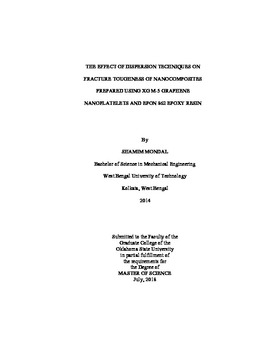| dc.contributor.advisor | Singh, Raman Pal | |
| dc.contributor.author | Mondal, Shamim | |
| dc.date.accessioned | 2019-03-20T18:46:01Z | |
| dc.date.available | 2019-03-20T18:46:01Z | |
| dc.date.issued | 2018-07-01 | |
| dc.identifier.uri | https://hdl.handle.net/11244/317613 | |
| dc.description.abstract | This investigation reports on the effects of various mechanical dispersion techniques, surface treatments, and coupling agents on the fracture toughness of an epoxy resin reinforced with graphene nanoplatelets. The epoxy resin selected is Diglycidyl ether of bisphenol F (DGEBF) . The graphene nanoplatelets are 99.5% pure graphene and added to the epoxy resin in an amount ranging from 0.1 to 2.0 wt.%. Ultrasonication and ball milling are used as high energy mixing processes for breaking up the aggregates of graphene nanoplatelets. Subsequently, ball milled graphene nanoplatelets are dispersed in solvents using ultrasonication and then added to the epoxy resin. A non-ionic surfactant that has a hydrophilic polyethylene oxide chain (on average it has 9.5 ethylene oxide units) and an aromatic hydrocarbon lipophilic or hydrophobic group where the hydrocarbon group is a 4-(1,1,3,3-tetramethylbutyl)-phenyl group (also known as Triton X-100) is used along with two different types of silanes, namely 3-glycidoxy-propyl-trimethoxy silane (GPTMS) and 3-amino-propyl-trimethoxy silane (APTMS) are chosen. Triton X-100 is 4-(1,1,3,3-Tetramethylbutyl)phenyl-polyethylene glycol. GPTMS and APTMS chains graft on GnP surface and take part in covalent bond formation with the epoxy matrix. Fourier transform infrared (FTIR) spectroscopy is used to evaluate the effects of chemical functionalization of graphene nanoplatelets and fracture toughness measurements are carried out using ASTM D5045. Spectral lines from FTIR analysis show us presence of covalent bonds between silane functional groups grafted on the surface of graphene nanoplatelets and epoxy groups after sample has been processed. ASTM D5045 test results show highest fracture toughness values for 1.0 wt.% samples processed using 3-amino-propyl-trimethoxy silane (APTMS) when compared to other samples. Overall, fracture toughness values of samples processed using 3-amino-propyl-trimethoxy silane (APTMS) is higher than 3-glycidoxy-propyl-trimethoxy silane (GPTMS) which in turn is slightly higher than the surfactant, Triton X-100. The samples processed using modifications had the highest fracture toughness values and on the other hand samples that had no modifications had the lowest fracture toughness values. SEM images show agglomerations forming when no modification technique was used. All other samples had considerably less visible aggregation sites. All these show that modifications techniques used for dispersion of graphene nanoplatelets in epoxy do work and it improves fracture toughness values while reducing aggregation of graphene nanoplatelets. | |
| dc.format | application/pdf | |
| dc.language | en_US | |
| dc.rights | Copyright is held by the author who has granted the Oklahoma State University Library the non-exclusive right to share this material in its institutional repository. Contact Digital Library Services at lib-dls@okstate.edu or 405-744-9161 for the permission policy on the use, reproduction or distribution of this material. | |
| dc.title | Effect of Dispersion Techniques on Fracture Toughness of Nanocomposites Prepared Using XG M-5 Graphene Nanoplatelets and EPON 862 Epoxy Resin | |
| dc.contributor.committeeMember | Vaidyanathan, Ranji | |
| dc.contributor.committeeMember | Sallam, Khaled A. | |
| osu.filename | Mondal_okstate_0664M_15807.pdf | |
| osu.accesstype | Open Access | |
| dc.description.department | Mechanical and Aerospace Engineering | |
| dc.type.genre | Thesis | |
| dc.type.material | Text | |
